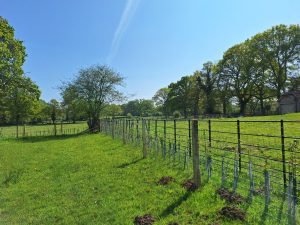New Forest nature project helping species thrive
PUBLISHED ON: 11 JUNE 2025A project to restore nature and boost biodiversity is helping the New Forest remain a beacon of light for wildlife.
The Species Survival Fund project is in its second and final year and has already unearthed some welcome discoveries in the Forest.
The project is led by the New Forest National Park Authority (NPA) in conjunction with five partner organisations and works to reduce species decline and restore habitats in the Forest with new ponds, meadows, hedgerows and heathlands created.
The NPA, Freshwater Habitats Trust (FHT), Amphibian and Reptile Conservation Trust (ARC), Wild New Forest (WNF), Hampshire and Isle of Wight Wildlife Trust (HIWWT) and the Commoners’ Defence Association (CDA) have been liaising with landowners to enhance 250 hectares of land – the equivalent of 350 football pitches – for nature across 25 sites.
John Stride, the NPA’s Net Zero with Nature programme manager, said sharing expertise and knowledge among local groups and communities for the project will ensure the Forest is in a strong position to counter future pressures.
‘The Species Survival Fund project is neither the start nor the end of this journey,’ he said.
‘Since time began, this has been a special place for wildlife and nature and we will keep working to make sure that continues and grows, especially as we face increasing pressures from climate change and other factors.
‘The relationships and partnerships being built between the nature conservation community, landowners, businesses and the public and communities is going from strength to strength in the New Forest and the Species Survival Fund is a critical part of that journey.
‘We will be monitoring these sites into the future to check how they are doing and take any learning we can.’

Partners have worked at more than 20 different sites during the first year of the project in the Forest, helping to improve habitats and re-establish links between habitats to allow species to thrive.
This has included creating and restoring open heathland by ARC for three of the most threatened reptile species – sand snake, smooth snake and adder – through the clearance of overgrown gorse.
FHT has created new ponds to enable freshwater species to develop and thrive, while new wildflower meadows, carved out on a number of sites by HIWWT, is giving insects and pollinators a welcome boost to the size and range of their habitats.
Meanwhile, nearly 40 rare species were recorded by Wild New Forest at 10 sites, mostly around the northern and southern fringes of the National Park.
Many were relatively familiar and widespread in the Forest, such as goshawk, raft spider, and wood cricket, but some of the surprising discoveries included a new species of fungus for Hampshire, a new pine marten and a pond full of Hampshire purslane – a nationally rare aquatic plant that is almost wholly restricted to the New Forest.’
On some of the sites, there are several partner organisations working together, sharing local expertise and knowledge to ensure the landscape is enhanced in the best way possible.
John believes this collaborative effort provides the best opportunity to unlock the ‘sheer potential’ of the New Forest.

‘Seeing the individual projects come together is fantastic, as this type of collaboration is so critical to having a New Forest that is healthy and resilient to climate change,’ says John.
‘Through partnerships I am always reminded of the sheer potential of the Forest. We are used to large-scale, impactful nature improvement projects, but every time we bring expertise together in this way, it highlights just how special and unique the landscape is.
‘The connections between people, communities, enthusiasts, experts, traditional practices, wildlife and nature paint such a rich and vibrant landscape in the New Forest.
‘You cannot help but feel positive for the long-term future of the place, even in the face of some of the challenges we’re facing like climate change.’
New Forest commoning is also benefiting from the project. Commoners turn out ponies, cattle, pigs and other livestock on the Forest at certain periods throughout the year and the animals’ health and overall condition relies heavily on the environment they are surrounded by.
‘Grazing by stock animals is particularly important for many of the habitats we are working with,’ added John.
‘And strengthening the connection between the habitats of the Open Forest and the surrounding landholdings is critical to the future of the unique commoning system.
‘It is fundamental to the ecosystem and culture of the New Forest National Park.’
Find out more about the Species Survival Fund project here
The project is funded by the Government’s Species Survival Fund. The fund was developed by Defra and its Arm’s-Length Bodies. It is being delivered by The National Lottery Heritage Fund in partnership with Natural England and the Environment Agency.
Pictured above: ARC principal ecologist Paul Edgar

